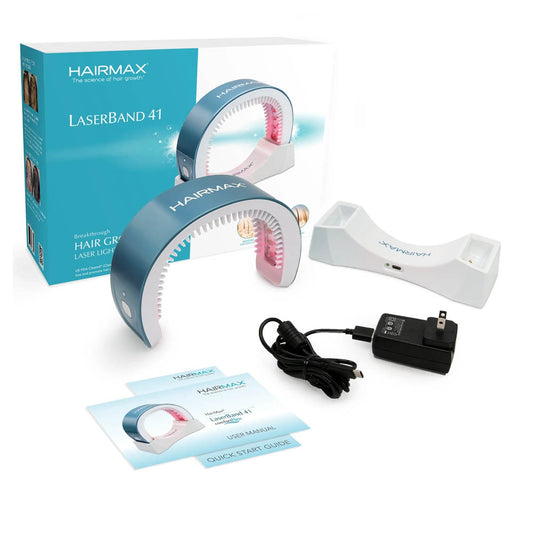
Do you know how much hair fall is normal?
Share
Have you ever looked down at your shower drain while taking a shower and noticed a distressing amount of hair? You thought to yourself, you might have in advertently rubbed your scalp a little too roughly and caused your hair follicles to freak out, but what if this sign of hair shedding actually means something more, like an onset of something far more serious?
Fact is, it is completely normal to shed up to 100 strands of hair every day. According to the American Academy of Dermatology Association, losing between 50 to 100 hair per day is not a cause for concern. The main reason for this shedding is due to the hair’s natural growth cycle. However, if you star noticing that your hair is falling out more for weeks on end, then it might be worth looking into why this unusual occurrence is happening and how to fix it.
To get a clearer understanding on why changes in hair loss occur and the best way to address it, we had a chat with our resident trichologist at Vivandi Trichology Center. Here's what they had to say.
WHAT IS NORMAL HAIR LOSS?
While the average person loses about 50 to 100 strands per day, Zahra Darwish, Trichologist at Vivandi Trichology Center states that over 150 strands is fairly unusual and needs to be assessed for any underlying condition.And while counting the amount of hair we shed daily is not feasible, it is crucial to pay attention to the amount of hair that is left in your hands after showering, after brushing your hair, or on the bottom of the bathroom floor.
Hair growth is a dynamic process and can be divided into three distinct phases, states the Trichologist.There are 3 stages of hair growth in the cycle, from actively beginning growth from the root to hair shedding. These are known as the Anagen phase, Catagen phase and Telogen phase. In summary:
-
The Anagen or Growth Stage:
The stage where the hair grows and thickens as the cells in the hair bulb proliferate rapidly. It usually lasts for about 3 to 5 years before hair follicles become inactive. -
The Catagen or Intermediate Stage:
It is the transition phase when the hair follicles prepare themselves after active growth for the resting stage, and it generally lasts around 1-3 weeks. The appearance of club hair characterizes this intermediate phase when the hair shaft separates from its roots. The hair follicles shrink and lose about 15% of its diameter as their deeper portions collapse. -
The Telogen or Shedding Stage:
It is the final stage of the hair growth cycle that starts with resting and then shedding of hair. The hair follicle remains dormant, and the hair shaft stops growing. Up to 15% of our body hair is in this stage at any point in time. It usually lasts for about 3 to 4 months during which the resting club hairs fall out and allow new hair growth to occur. Around 75-100 hairs are shed each day during the telogen phase.
However, there are other phases we often go through where we will shed more than the normal amount. One of these is called Seasonal Shedding, which is an increase in shedding during a particular time of the year. A few months after, when we begin shifting into late fall and early winter, those hairs that we held onto during summer will make a transition into the shed phase. The result: a temporary increase in shedding compared to your baseline.
WHAT CAUSES HAIR LOSS?

There are a variety of reasons that can cause hair loss: stress, hormonal changes, childbirth, thyroid issues, medications, vitamin deficiencies, excessive weight loss, and some autoimmune disorders.
If you suppose your hair has been shedding more for longer than three months, consider seeking a consultation with a specialist or a trichologist for a correct diagnosis of the condition and a suitable treatment course. If possible or if advised by the trichologist, go for a series of blood work to rule out any underlining condition.
What’s important to know is that once the issue has been properly identified and an action plan has been provided,abnormal shedding will most of the time correct by itself and the hair will revert its normal hair cycle, keeping in mind that it could take around 3-6 months for the situation to be rectified.
HOW TO COMBAT HAIR LOSS?
“The healthier your body, the healthier your hair is” says Zahra Darwish. Her helpful tips for staying healthy and having healthy hair includes:
- Eating a well-balanced diet. Consume more foods which are rich in protein.
- Taking dietary supplements with biotin, zinc and iron.
- Maintaining a healthy & clean scalp. Keeping a healthy environment for hair to grow is key.
- Wash and shampoo your hair regularly to eliminate build-ups, dirt, sebum, sweat and hair products. Use gentle and sulfate free shampoo.
- Avoid wearing tight hair styles, such as ponytails, buns and tight braids.
Hair loss is definitely frustrating for women and men alike. But before you start to worry, consider consulting with a trichologist to determine if your hair lossis from shedding or breakage,and with the right course of treatment, hair loss or hair shedding is often reversible.



